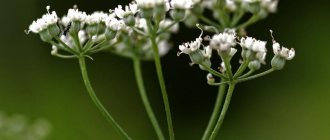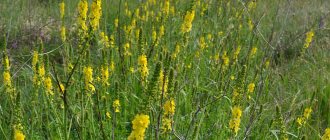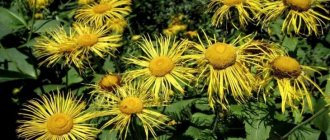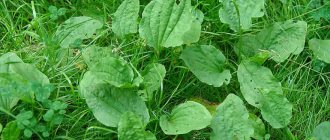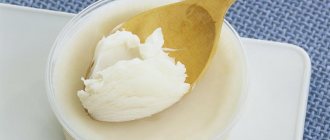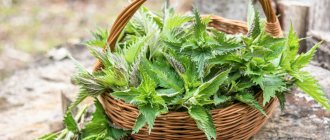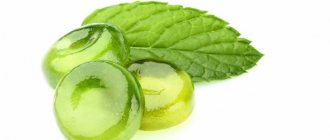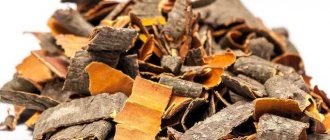Blue cyanosis is an ornamental herbaceous plant that belongs to the cyanosis genus (Polemonium) of the cyanosis family (Polemoniaceae).
The medicinal properties of blue cyanosis are recognized by official medicine as an effective remedy for the treatment of bronchopulmonary diseases, including tuberculosis, stomach and duodenal ulcers. The plant has pronounced sedative (calming) properties and is 8-10 times more effective than valerian.
Blue cyanosis is a plant, a summer honey plant, one of the main taiga honey plants in Siberia. Due to its exceptional decorative properties and delicate aroma, it is grown in flower beds and front gardens.
Blue cyanosis. Kinds. Photo
The genus cyanosis, in addition to blue cyanosis, includes about 40 species, including:
- northern blueweed – Polemonium boreale Adams;
- large-flowered blueberry – Polemonium macranthum Klokov;
- hairy cyanosis – Polemonium pilosum () GNJones;
- beautiful cyanosis – Polemonium pulchellum Bunge;
- cystic cyanosis – Polemonium racemosum, etc.
Some of them, for example, creeping cyanosis (Polemonium reptans L.), are used for medicinal purposes.
Blue cyanosis. Subspecies
Blue cyanosis has two varieties:
- Polemonium caeruleum var. Acutiflorum (ex Roem. & Schult.) Ledeb.;
- Polemonium caeruleum var. Caeruleum.
Blue cyanosis in Latin : Polemónium caerúleum L.
Other names: azure cyanosis (azure), Greek valerian, overcome-grass, bran-grass, blue St. John's wort, dvusil, harmful grass, mother plant.
Caring for cyanosis
Blueberry is a perennial plant. It is not difficult to care for, although good care works wonders - the cyanosis responds to it with lush flowering.
Place. The plant is light-loving, but tolerates partial shade. With sufficient light, the variegated form has more contrasting foliage. It is better to grow tall species of cyanosis, one meter high, in a protected place where the wind cannot scatter the bush. In open space, long erect stems have to be tied to a support.
The soil. Cultivated soils are preferable. In clay and sandy areas, compost is applied and peat is added (to structure the soil). Blueberry has a short, thick, creeping rhizome and thin adventitious roots.
Watering. Blueberry blooms even in dry summers, but loves the soil under it to be moistened. Regular watering prolongs flowering time.
Trimming. If seeds are not needed, then cut off all faded inflorescences. As soon as the blueberry finishes blooming, all its stems can be removed or shortened. Mowing them stimulates the growth of young shoots, which sometimes manage to form new inflorescences in the same year. The variegated form is good even after flowering has ended, so only faded inflorescences are removed. For the winter, the shoots of the cyanosis are cut off so that “stumps” about 5 cm high and the lowest leaves remain.
Winter hardiness . Blueberry is a frost-resistant plant. In winter, the basal leaves are usually preserved under the snow.
White-flowered form of blue cyanosis
Blue cyanosis. Botanical description
Blueberry is a herbaceous perennial. Height: 40-100, up to 150 cm. The rhizome is short, thick, creeping, located horizontally. Length: 5 cm, width: 3 cm. The roots are numerous, fibrous. The taste is initially bitter, then sweetish, mucous.
In the first year, basal leaves grow. In subsequent ones - stems. Young plants have one stem, older plants have several. The stem is vertical, hollow, unclearly ribbed, and may weakly branch in the upper part.
The basal leaves of blue cyanosis are arranged in a rosette. Stem plants are alternate, imparipinnate, smooth, the lower ones have petioles, the upper ones are sessile. They consist of 17-21 oblong-ovate pointed leaves.
The flowers are broadly bell-shaped, five-lobed, collected in an apical elongated paniculate inflorescence. Color: bright blue, light blue, dark purple, white. Diameter: about 2 cm.
The fruit is a round, three-locular, multi-seeded capsule. Easily cracks. The seeds are small, angular. Color: dark brown, black. Length: 3 mm. Weight of 1000 seeds: about 1.5 g.
It blooms from the second year in June-July. The seeds ripen in August-September. Propagated by seeds, division of rhizomes.
Procurement of raw materials
The most valuable substances are found in the roots of young plants. They start collecting them in August-September. The roots are located close to the surface of the earth, so they can be easily removed by hand. Having rid the future raw material of lumps of soil, it is separated from the stem, washed and placed in a dark, well-ventilated place.
If you leave the plant in direct sunlight, it will lose its medicinal properties. During drying, the plant is periodically turned over to achieve a uniform effect. If you don't have the time or space to dry it outside, use a dryer or oven.
First, cut the rhizome into small cubes up to 2 cm long or into thin strips, place it in a drying machine at a temperature of no more than 50C. To find out if the raw material is ready, try to mash it. Roots ready for storage will be brittle.
Blue cyanosis. Habitat
Blue cyanosis has become widespread in Western Europe and the Scandinavian Peninsula, as well as in the European part of the CIS, the Caucasus, Western and southwestern Eastern Siberia.
Where does blue cyanosis grow? The plant prefers fertile soils. It can be found in forest clearings and edges, along the banks of reservoirs, in wet meadows, forested mountain slopes and among bushes. Grows singly or in small groups.
Grown on an industrial scale. As an ornamental plant, blue cyanosis is used in landscape design; it looks especially good in groups near bushes.
Variety of species
Blue blue (azure). This is the most common type, valued for its unpretentiousness and unique medicinal qualities. A beautiful bush 40 - 100 cm high (less often up to 120 cm) grows best in light or partial shade. The species is moisture-loving, frost-resistant (down to minus 35˚C).
June - July is flowering time. Repeated flowering may occur in August - early September. The traditional color of the flowers, collected in a racemose panicle, is blue-blue. The large-flowered form is prized. The white-flowered form is also magnificent. It is worth paying attention to the garden variety “Variegata” with bright variegated leaves. The variety "Breeze d'Anjou" ("Breath of Anjou"), 70 cm high, has green leaves with a white edge.
Blueberry multifolia. The height of the shoots is up to 90 cm. This is a drought-resistant species. Blooms for a long time, from June to September. The color of the flowers is blue-lavender. Low varieties are popular: “Sapphire” (45 cm high with sky-blue flowers) and “Blue Pearl” (“Blue Pearl”), 30 cm high, with dark blue flowers.
Richardson's cyanosis. It has sky blue flowers with a sweetish scent. Decorative and lush foliage. Well-known varieties: “Album” (height 40 cm) with white flowers and “Superbum” (height 50 cm) with violet-blue flowers. A special feature of care is high requirements for constant soil moisture.
Creeping cyanosis. It is worth taking a closer look at this early-flowering species if you want to create a flowering lawn with blueberry in which the stems are pressed to the ground in a sunny place or in partial shade. In May–June, bright blue flowers appear, collected in slightly drooping inflorescences. Flowering is abundant. The variety "Stairway to Heaven" has bluish-green leaves with a wide cream edge. The height of the bush is no more than 30 cm.
Low-growing species. Compact, low-growing species (8 to 30 cm) of cyanosis (graceful, northern, chartaseum, small-flowered, pretty, sticky, etc.) are suitable for rock gardens.
Blue cyanosis. Collection and preparation
For medicinal purposes, rhizomes with blue cyanosis roots are harvested, and less commonly, grass (stems, leaves, flowers), which has less pronounced medicinal properties.
Harvesting blue cyanosis (grass) is done in June-July, roots - in the fall, after the above-ground part dies. Be sure to leave at least 15-20% of mature plants to restore the thickets.
The remaining stems are cut off from the dug roots and quickly washed in running cold water. Then cut lengthwise into 2-4 pieces and dry in the open air (in the sun, if possible), spreading them out in a thin layer, not forgetting to turn them over periodically. The smell of the finished blue cyanosis raw material is weak and peculiar. Taste: bitter.
Dried raw materials are stored in boxes or bags made of natural material in a room with good air ventilation. Shelf life of blue cyanosis: 2 years.
Growing polemonium
Polemonium is easily propagated by seeds . Seeds can be sown directly into the ground before winter, in October or in spring, at the end of April, when the snow melts and the soil is ready for sowing. Polemonium seeds can be sown as seedlings in February-March. But in this case, the container with the sprouts will have to be kept in the refrigerator.
Polmonium seeds are lightly sprinkled with soil. Polemonium seedlings germinate at a temperature of +4 °C. The plant does not require any light at all and grows well in long day conditions.
Using all my experience, both negative and positive, in growing flowers, I will offer another option for sowing seeds. Plant polemonium seeds in a seedling container, moisten the soil with the sown seeds, wrap them in a plastic bag and safely take them out into the garden. In the garden, in any accessible place, dig up the snow to the ground, place a container with planted seeds there and cover it with snow. All. When the snow melts, the container with seeds or seedlings can be transferred to any other place, for example, to a greenhouse or greenhouse. And then transplant it into open ground.
- Firstly, this way you won’t lose the place where you plant. For example, I can plant something different in the same place ten times. I’m very impatient, it seems to me that only mine is growing very slowly or the seeds are not germinating at all;
- Secondly, with this method of sowing, you will know for sure that what you planted has sprouted, and not grass or weeds. Especially if you are planting this plant for the first time and cannot tell by the leaves whether what has sprouted is grass or flowers. Many times I pulled out my flowers instead of grass;
- Thirdly, your refrigerator will only freeze food, and save space on the windowsill for tomatoes and peppers.
- Fourthly, the stratification for seeds is very real, natural, and seedlings in such conditions appear strong, do not stretch out and do not get sick, not like on the windowsill. In this way, you can grow all perennials, for example, delphinium, aquilegia and many others.
In the first year of cultivation, polemonium grows very slowly. However, in the second year it begins to grow much faster. Its growth begins right under the snow. Polemonium easily tolerates transplantation in early spring or autumn.
Non-acidic, moderately fertilized, light soil is suitable for polemonium. Polemonium will develop best in an area blown by moist winds in partial shade or sun. Polemonium loves moisture very much, so areas with shallow groundwater are suitable for planting it.
Blue cyanosis. Chemical composition
The beneficial and medicinal properties of blue cyanosis are determined by the components in its composition. Triterpene saponins (20-30%), organic acids, essential and fatty oils, starch, D-galactose, L-arabinose, and resinous substances (1.28%) were found in the roots.
In addition, the roots of blue cyanosis contain macro- and microelements: potassium (21.2 mg/g), calcium (12.2 mg/g), magnesium (3.6 mg/g), iron (3.52 mg/g) , as well as zinc (0.73 µg/g), molybdenum (0.6 µg/g), chromium (0.67 µg/g), aluminum (1.12 µg/g), barium (2.3 µg/g) d), selenium (5.5 µg/g), cadmium (4 µg/g), silver (96 µg/g), boron (70.4 µg/g), etc.
Reproduction methods and influence on planting technology
There are three ways to propagate polemonium, so the planting technology depends on the choice of the method you like. Let's figure out how to plant polemonium in all possible ways.
- Propagation by seeds. Flowering ends with the formation of seed pods, which, after ripening, produce a sufficient number of seeds that can be sown at different times of the year - in the fall, before winter, or in the spring of the new year. Autumn planting is the simplest, since the seeds undergo natural stratification, so there is no need for additional manipulations with planting material. But in the spring, seeds should be planted only after artificial stratification in the refrigerator, or by seedling method. Remember, although seedlings are a more troublesome process, you get flowering already in the first year of the growing season. The seeds should be sown to a depth of two centimeters, and within three weeks you will get full-fledged seedlings.
- Reproduction by root division. This method is considered the simplest and most effective, since the adult plant immediately continues its growing season, thereby not slowing down the flowering process. The division procedure is classic, there are no subtleties or nuances, everything is according to the rules. It should be understood that dense plantings are not for polemonium, so try to maintain the required distance from thirty centimeters to half a meter.
- Propagation by cuttings. This method is also popular and practical, it involves rooting the cut tops. The dimensions of the cutting should barely exceed 10 cm. Planting does not occur immediately in the selected area, but somewhere under the tree. Create a greenhouse from a regular plastic bottle with a cut. Water and observe, as soon as the plant begins to form a root system, it will definitely let you know and begin to grow. When the plant gets stronger, it can be transplanted to a permanent place; it is not afraid of transplants.
Blue cyanosis. Use in folk medicine
A large number of people, freely using plants to treat various diseases, believe that they are absolutely harmless. However, among medicinal plants there are potent, toxic and even poisonous ones. In addition, many people, especially older people, have several chronic diseases.
Therefore, in order for the treatment to be effective, when using it, one should take into account the beneficial and medicinal properties of blue cyanosis and the contraindications that it has, and this can only be done by a doctor. Based on this, before you start taking blue cyanosis medications, consult a doctor, or better yet, a herbalist you trust. The information given below is for informational purposes only.
Vascular diseases
The use of blue cyanosis (grass, roots) gives a good effect for atherosclerosis. The substances in its composition help reduce cholesterol in the blood, normalize fat and cholesterol metabolism in the body, and inhibit the development of the disease.
For the brain
Traditional medicine uses the plant for certain brain diseases, for example, headaches. Also, a good effect was obtained from the use of blue cyanosis for epilepsy.
Colds and bronchopulmonary diseases
The plant has pronounced expectorant properties, so blue cyanosis has proven itself to be a good treatment for respiratory diseases, such as acute respiratory diseases, febrile conditions, bronchitis, including chronic bronchitis, bronchiectation, pneumonia, tuberculosis, whooping cough, etc.
Gastrointestinal diseases
Treatment with blue cyanosis preparations is recommended for gastritis, stomach and duodenal ulcers. It also helps with dysentery.
Nervous system diseases
In both official and traditional medicine, blue cyanosis medications are recommended for mental and nervous diseases, to restore the nervous system. In its effects, the plant is several times superior to valerian, widely known for its calming properties. Blue cyanosis has a good effect on insomnia and reduces the manifestations of nervous tics.
In folk medicine, plant preparations are used to treat rabies.
For women
The benefits of blue cyanosis for women's health have found application. An infusion of leaves (flowers) is used for douching for leucorrhoea. It is also used for rinsing hair after hygienic washing for baldness.
Skin diseases
Blue cyanosis (herb, root) has proven itself well for the treatment of a number of skin diseases, such as eczema, psoriasis, neurodermatitis, pruritic dermatosis, collagenosis, vitiligo, lichen planus.
Wounds, cuts
In folk medicine, blue cyanosis is used as a poultice for snake bites.
Metabolism
The use of blue cyanosis to normalize metabolism gives a complex effect. A decoction of the roots stimulates the function of the adrenal glands, regulates fat, cholesterol, and lipid metabolism.
Blue cyanosis preparations are prescribed for diseases associated with lipid metabolism disorders.
Benefits of the plant
The most valuable part of the cyanosis is the root. This is where starch, resin, organic acids, galactose, saponins, and various macro- and microelements are contained. For many centuries it has been used as a powerful remedy against various ailments.
So what properties does this plant have:
- Conquers diseases of the cardiovascular system. Cyanosis improves blood flow, prevents the development of stroke and heart attack. With it, irregular heartbeat, cardiosclerosis and angina pectoris are also not scary.
- Fights respiratory diseases. The plant prevents the development of pneumonia, bronchitis, tuberculosis and whooping cough. By getting rid of phlegm, it eliminates even the most severe cough.
- Normalizes the functioning of the nervous system. The root is used as a sedative. It relieves attacks of hysteria and anxiety, improves sleep and fights insomnia. To achieve quick results, use the plant in combination with motherwort and hawthorn.
- Improves the functioning of the urinary excretory system. By removing inflammation and swelling of organs, the herb prevents excessive accumulation of fluid and helps its rapid elimination.
- Fights endocrine disorders. Preparations based on cyanosis normalize blood sugar, which is important for a diabetic. They are used to improve metabolism and remove cholesterol from the body.
- Prevents diseases of the digestive system. The plant suppresses symptoms of gastrointestinal ulcers. It reduces inflammation and cleanses the blood.
- Copes with skin diseases. The root eliminates irritation and inflammation due to dermatitis. It also helps relieve symptoms of insect bites.
- It will cure diseases of the reproductive system. By eliminating genital dysfunction, nervous tension, spasms and stress, the plant will improve the functioning of the genital organs not only of women, but also of men.
Blue cyanosis. Dosage forms
Blue cyanosis decoction
2 tbsp. pour 250 ml of roots. water, bring to a boil and simmer over low heat for 15 minutes. Remove from heat, cover with a lid, insulate and leave for 45 minutes. Strain, squeeze out the raw materials. Using boiled water, bring the resulting broth to its original volume. Store in a cool place, such as a refrigerator, for no more than 2 days.
Take 1 tbsp. 3-5 times a day two hours after meals.
Blue cyanosis extract
To prepare the extract, use a decoction, which is poured into a container, brought to a boil and simmered over low heat until the volume of the liquid is reduced by half.
Take 1 tsp. 3 times a day before meals.
Blue cyanosis tincture
Fill a glass jar (preferably dark glass) halfway with blue cyanosis roots and fill to the top with high-quality vodka. Close the container tightly with a lid and leave in a dark place at room temperature for a month, remembering to stir periodically. Strain, squeeze out the raw materials.
Take 20 drops in water 2-3 times a day after meals.
Plant characteristics and nuances
At first glance, it seems that this plant is the most common and has no special requirements, so it grows successfully with minimal care. This is wrong. It should be understood that the plant has an unusual root - creeping and very little branched, so it can independently move around the site.
The flowering period is an indisputable culmination, which after the final chords becomes not at all attractive, not even very beautiful, so feel free to combine the plant with other decorative flowering representatives, perhaps with those that look larger, so that they take all the attention when the polemonium tries avoid prying eyes.
An alternative to an unsightly appearance is to completely cut the plant at the root when the flowering process is complete. The plant will begin a new round of development, new, young shoots will appear, which will not only give the plant an attractive appearance, but can even bloom again at the end of summer.
Blue cyanosis. Contraindications
In order for the treatment to be effective, it is imperative to take into account the benefits of blue cyanosis and the harm that it can cause if used incorrectly. The plant should be used with caution when:
- increased blood clotting or a tendency to this disease,
- hypertensive crisis.
Although the plant is low-toxic and when used in recommended doses, blue cyanosis does not cause side effects, however, when taking large doses, vomiting, diarrhea, headache, and shortness of breath may occur. In such cases, heart medications should be taken. In more severe cases, gastric lavage is performed
Sources:
D.S. Ivashin, Z.F. Katina. Medicinal plants of Ukraine.
Rim Akhmedov. Plants are your friends and foes.
I.N. Putyrsky, V. Prokhorov. Universal encyclopedia of medicinal plants.
A.P. Popov. Medicinal plants in folk medicine.
S.Ya. Sokolov, I.P. Zamotaev. Handbook of medicinal plants.
Advice from the traditional healer Evdokia. Herbalist, illustrated reference book.
Contraindications for use
Despite the large list of medicinal properties, the plant has a considerable number of side effects. Therefore, please read it before using it.
Decoctions and infusions based on cyanosis are contraindicated:
- children under one year old
- pregnant women
- nursing women
- People with high blood pressure and high blood clotting should be careful.
If you are not one of the above, you should still be careful when taking this medicine. Because overdosing it or taking it on an empty stomach can lead to serious consequences.
How to care for polemonium?
The rules of care are simple and minimal, since cyanosis is a less demanding and harmless plant. Nevertheless, generally accepted recommendations should be followed. Do not allow the plant to be forgotten by weeds, carry out systematic weeding, and actively fight against weeds.
Watering is an integral stage of care, since polemonium is very favorable to watering and does not tolerate drought. Water often, but not too much, stick to moderation. Don’t forget to loosen the soil after watering to prevent it from drying out and forming a dense crust.
Fertilizer is an improvement in the composition of the soil, which no plant will refuse. Accordingly, polemonium is also no exception, although it cannot be argued that it is an extreme measure. It is recommended to fertilize at the start of the season - in the spring - with a complex mineral fertilizer, which will enrich in sufficient quantities not only nitrogen, but also potassium and phosphorus. After feeding, you will notice not only rapid growth, but also larger-scale flowering.
Experts say that polemonium is a frost-resistant plant, so it does not particularly need shelter for the winter, although mulching cannot be completely eliminated. To be completely sure that the plant will successfully overwinter, mulch the base with compost or humus. This will become not only a natural “insulation”, but also a kind of autumn organic feeding.
The above-described care should be carried out systematically for five years, after which it is recommended to carry out a rejuvenation procedure - transplantation to a new place.
